Loïck Peyron / Banque Populaire V
The world’s biggest ocean trimaran would defy space and time. Loïck Peyron and thirteen high-level sailors launched the Banque Populaire V machine in their quest for the mythical Jules Verne Trophy. Consistently ahead of the existing record, the maxi yacht felled obstacles, thwarted traps, and pushed its luck to beat the timer.
On 22 November, at 9 hours, 31 minutes and 42 seconds, a blue rocket sped downwind, off Brittany’s Ushant Island(1)(1)Victoire autour du monde, Marie Le Berrigaud-Perochon, éditions Mer et Découverte, 2012.. The starting line of the Jules Verne Trophy was thus crossed by the world’s biggest trimaran. Measuring 40 meters long, 13 meters wide, with 450 m2 in mainsail, the maxi Banque Populaire V (“BPV”) recorded an average of 30 knots as it set off on the race, holding onto the promise of reaching the equator in under six days.
On board were skipper Loïck Peyron, arriving at the vessel’s helm at short notice(2)(2)Banque Populaire V was a prototype conceived in 2006 by skipper Pascal Bidégorry and his sponsor, who entrusted its design to architects from the VPLP firm. As soon as the boat hit water in 2008, Pascal Bidégorry and his crew multiplied challenges and accumulated records. Following a disagreement between the sponsor and the Basque skipper, the Banque Populaire group appointed Loïck Peyron to take over the maxi’s helm for a second attempt at the Jules Verne Trophy. Find out more on: www.voile.banquepopulaire.fr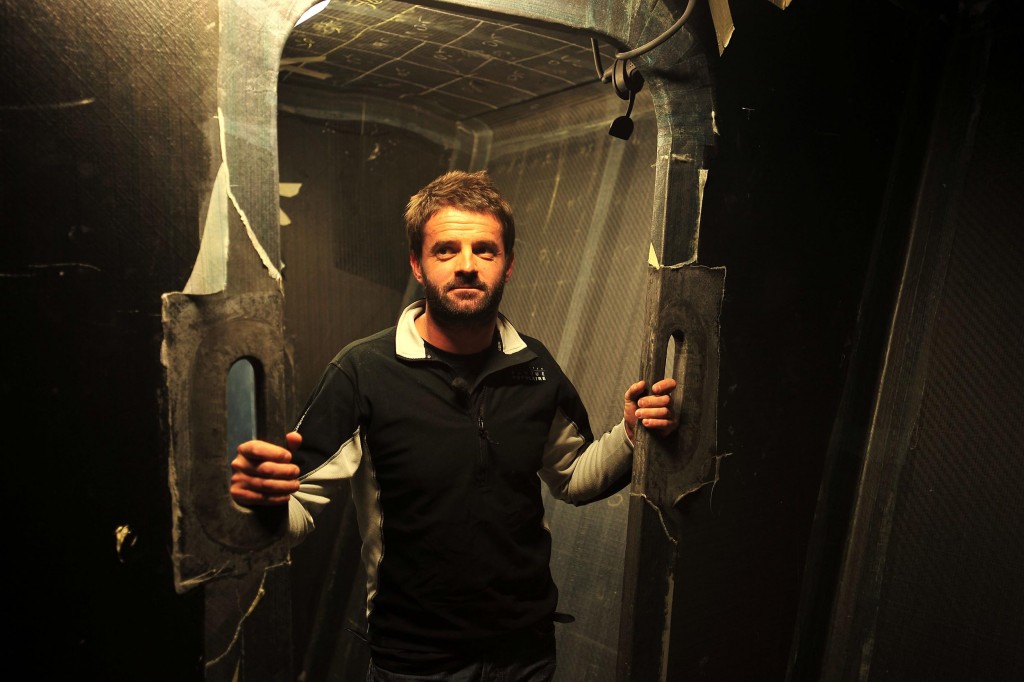
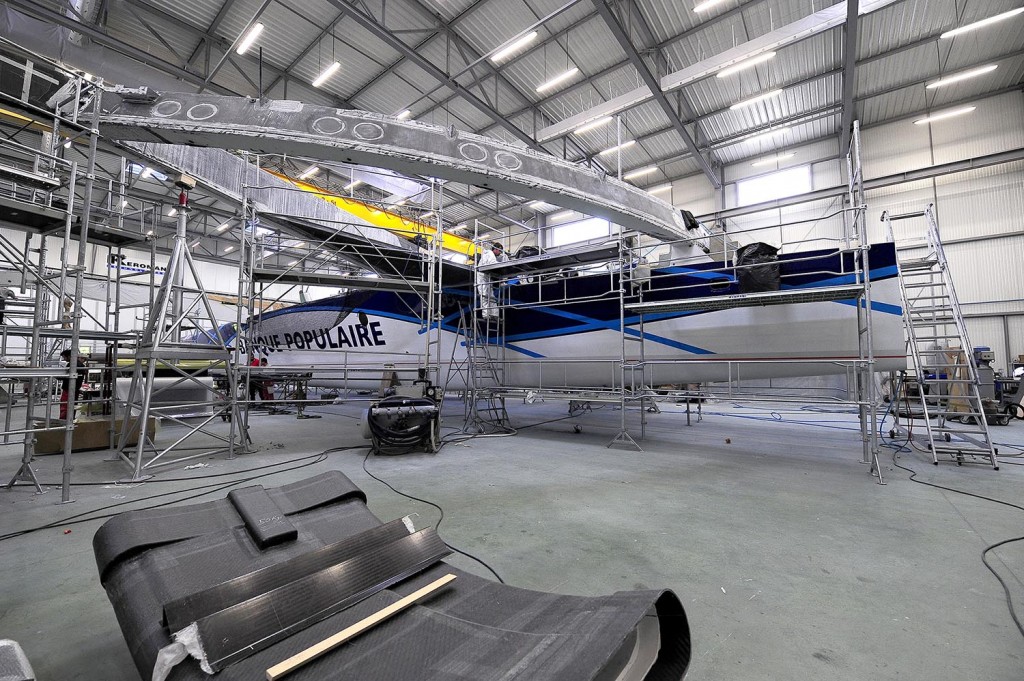 Pascal Bidégorry and the BPV ©Photo Yvan zedda / BFBP, and thirteen sailors from the “Banque Populaire team”: Thierry Chabagny, Florent Chastel, Thierry Duprey du Vorsent, Kevin Escoffier, Emmanuel Le Borgne, Frédéric Le Peutrec, Jean-Baptiste Le Vaillant, Ronan Lucas, Pierre-Yves Moreau, Yvan Ravussin, Xavier Revil, Brian Thompson and Juan Vila.
Pascal Bidégorry and the BPV ©Photo Yvan zedda / BFBP, and thirteen sailors from the “Banque Populaire team”: Thierry Chabagny, Florent Chastel, Thierry Duprey du Vorsent, Kevin Escoffier, Emmanuel Le Borgne, Frédéric Le Peutrec, Jean-Baptiste Le Vaillant, Ronan Lucas, Pierre-Yves Moreau, Yvan Ravussin, Xavier Revil, Brian Thompson and Juan Vila.
Half of the crewmembers were racers with a penchant for high speed and its accompanying peaks of adrenaline. Loïck Peyron would have to temper their zeal and impose, with his experience of Cape Horn, a principle that has always guided the Trophy’s challengers: that of above all bringing back the boat and the men!
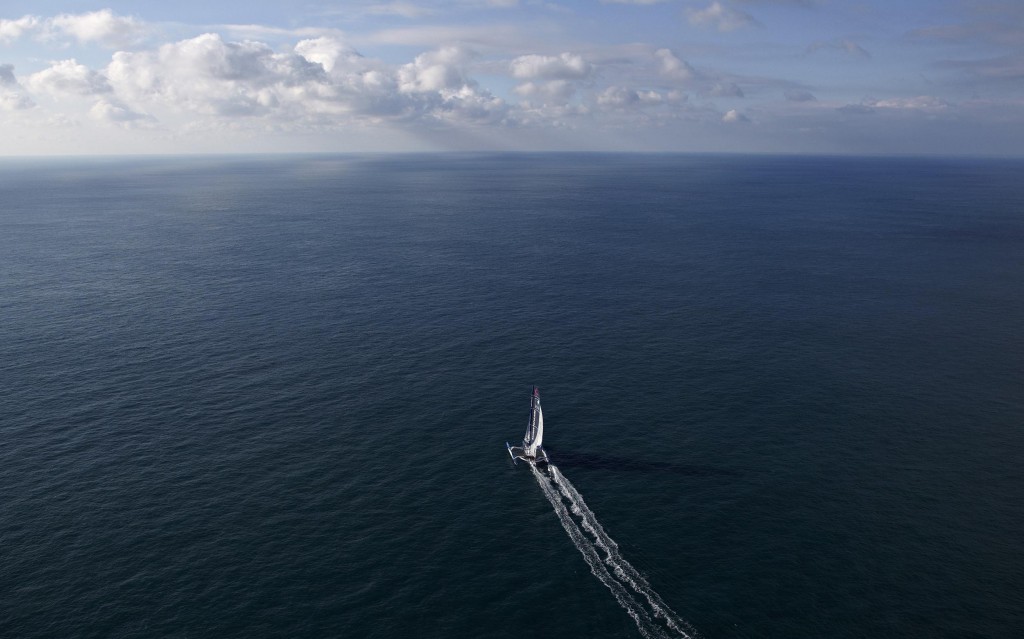 © Photo Benoit Stichelbaut / BFPD
© Photo Benoit Stichelbaut / BFPD
Braking the machine
The recidivists on board were well aware that to win, it was necessary to get back. The world tour via the three capes is a test of endurance as much as it is of speed, punctuated by the turns in the weather. Peyron’s thirteen men would need to learn to slow down their mount in order to spare the equipment.
From the Baleares, Marcel van Triest, the land-based router sketched out the best possible route with them to finish the itinerary in a record time. The reference time to beat was the one set by Franck Cammas who won the Jules Verne Trophy on Groupama 3, in 2010, in 48 days, 7 hours, 44 minutes and 52 seconds.
After a sporty first night, with the sea chaotic off Portugal, BPV headed straight for the Canaries. The boat’s average speed at that point swung between 27 and 29 knots.
Loïck Peyron suddenly decided to bend his itinerary 90° to the south. The boat headed west to latch onto an easterly wind rotation and a better angle for going down. For several hours, the trimaran dropped speed, but the strategy paid off.
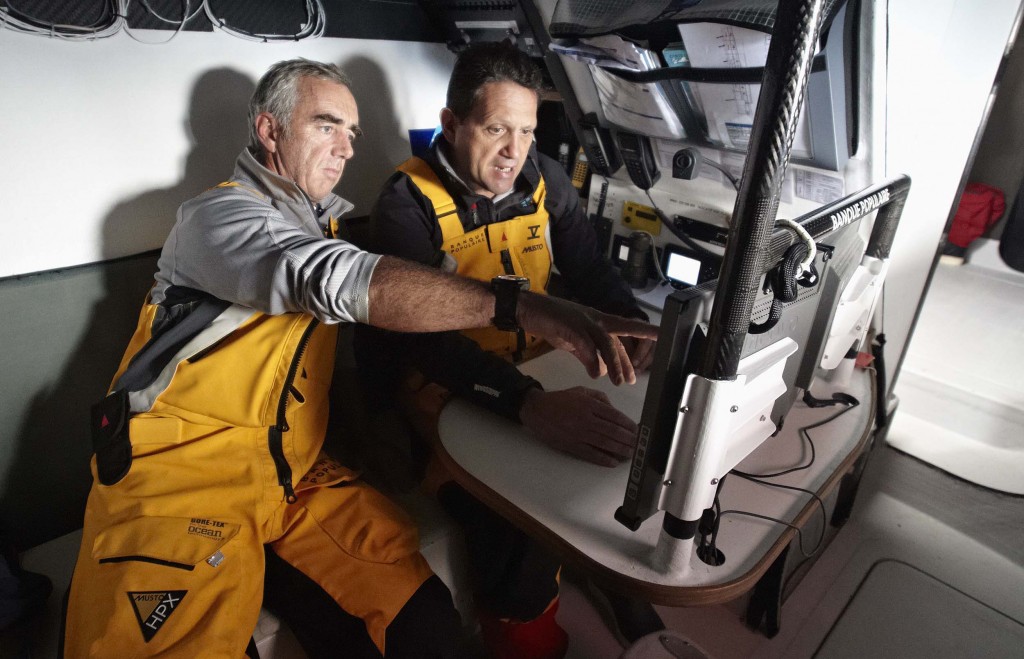 Loïck Peyron and Juan Vila © Photo Benoit Stichelbaut / BFBP
Loïck Peyron and Juan Vila © Photo Benoit Stichelbaut / BFBP
Galloping to the equator
On the fourth day of sailing, 666 miles (1,071 km) were covered in the space of 24 hours. BPV cavorted under northeasterly wind at 20 knots (37 km/h): the trade winds were regular, the sea smooth. On board, the rhythm was intense. It was constantly necessary to take in or let out sailcloth in an attempt to restrain the “machine” without braking her stride. “We’ve changed direction a little, we’ve shifted the point where we cross the Doldrums. The cloud gurus have found us a little hole where we have to slip through,” reported Florent Chastel on the radio. “For now, we have the full mainsail and solent, between 100-110° wind at around twenty knots, and we’re progressing at 32-33 knots. The sea’s fairly flat, it’s not bumpy, it’s really pleasant. We’re keeping up crazy averages.”
There was no respite for the 14 men on BPV. The doldrums – that zone near the equator where flat calmness alternates with violent squalls – were spread out over a wider area than expected, and rough to boot. During the radio session on 26 November, Loïck Peyron described jumps from 18 to 32 knots in just a few seconds(3)(3)For detailed transcripts of the radio sessions, see: www.fralo.info. “We’ve been seeing a really active side of the Doldrums in the last 24 hours or so, it’s a little long, a little wearing. We’re in a hurry to get out quickly.” (4)(4) Radio session, November the 27th , with Loïck Peyron.
BPV was only 60 miles (96 km) ahead of its virtual rival when it finally got out. And on Sunday 27 November 2011, at 23 hours, 26 minutes and 52 seconds (GMT), Loïck Peyron was only 28 minutes and one second in front of Franck Cammas when crossing the equator. And so the maxi trimaran picked up its first record on the Jules Verne course: Ushant-Equator in 5 days, 14 hours, 55 minutes an 10 seconds.
Obscene!
The next obstacle: Saint Helena’s High, a calm zone in the South Atlantic. The conditions for getting around it were good, according to the forecasts of land router Marcel Van Triest. The Banque Populaire Team traced a wide curve to skirt around the phenomenon along its southwest boundary and then went south. The detour was unavoidable, but the boat’s speed didn’t flag, and the distance between BPV and its virtual rival widened.
At 43°South, on 2 December, air and water temperatures plummeted while winds went up to 35 knots (64 km/h). Equipped with the mainsail and two reefs and the forestaysail, the maxi trimaran, reined in by its pilots, sailed with a 955-mile (1536 km) lead on the benchmark time.
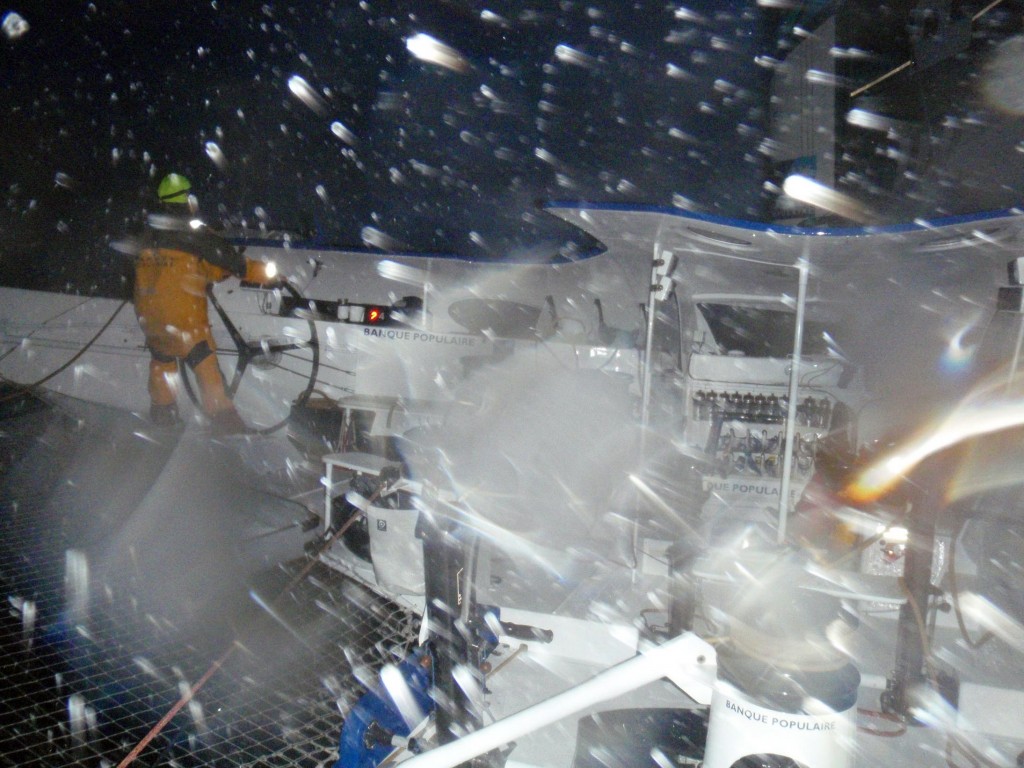 Photo du bord / © BFBP
Photo du bord / © BFBP
On 4 December, the 14 sailors left the Cape of Good Hope behind them, after 11 days, 21 hours, 48 minutes and 18 seconds(5)(5)Until then, the absolute record between Ushant and the Cape of Good Hope was 13 days, 6 hours and 1 minute. Peyron improved the time set by Cammas in 2010 by 2 days, 15 hours, 43 minutes and 25 seconds.. A new record was notched up by the maxi! “11 days and 21 hours, it’s obscene,” remarked Loïck Peyron on the radio session of the day. “A few decades ago, 12 days was the time taken by Charlie Barr to cross the Atlantic. Tabarly was the first to do the Atlantic in a little under 12 days, barely 20 years ago.”
Indian express
Entering the Indian Ocean, Banque Populaire V headed towards the Kerguelen Islands. Pushed by a northwesterly wind, the giant trimaran faced big swells that forced the sailors to slow down once again. On board, the rule was strict: no faster than 30 knots!
Prudence was de rigueur at 48° South: here, visibility was limited and an iceberg field was indicated east of the Kerguelen Islands, a hundred or so ice blocks measuring several kilometers long below 50° South.
On 6 December, despite a relative slackening in pace, the crew managed to gulp up 800 miles (1287 km) in 24 hours. “It’s only the third time that a boat has reached averages of 800 miles per day,” rejoiced Kevin Escoffier, engineer and design-office manager in the Banque Populaire Team. “And what’s particularly impressive is that it’s happening on a world tour.” Only Groupama 3 and Banque Populaire V had ever gone over this threshold when the record for crossing the North Atlantic was broken in 2009.
After only 15 days of sailing, with a 1933-mile (3110 km) lead on the record holder, the BPV team rounded the Kerguelen Islands from the south and prepared to climb back up north to get around the ice and scuttle towards Cape Leeuwin, the next obligatory passage point on the course.
With Australia in its sights, the blue trimaran caught up with a depression which allowed it to continue to take advantage of a steady westerly flow.
On 10 December, the BPV skipper and his crew pocketed a new reference time: after 17 hours, 23 hours, 57 minutes and 18 seconds since Ushant, they passed the first Australian cape and shortly afterwards entered the Pacific, 3 days, 14 hours and 24 minutes ahead of the holder of the Jules Verne Trophy.
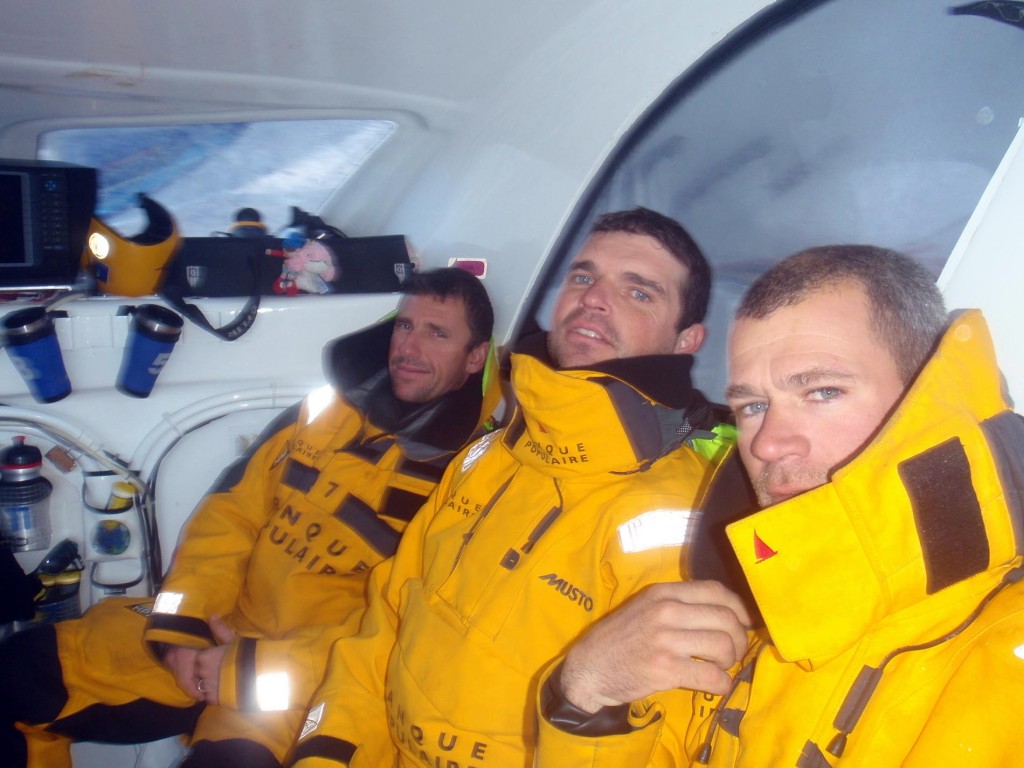 Xavier Revil, Pierre Yves Moreau and Thierry Chabagny. Photo du bord / © BFBP
Xavier Revil, Pierre Yves Moreau and Thierry Chabagny. Photo du bord / © BFBP
Pacific hotpot
The maxi trimaran steamed ahead on its crossing of the world’s biggest ocean. A 48-knot free-fall in the early morning of 12 December concluded a first chaotic night. The swell lengthened and the sea soon became easier to handle. (6)(6) Radio session, December the 12th. , with Loïck Peyron.
But the pleasure of gliding was short-lived. On 15 December, a front arriving from northern New Zealand hit Banque Populaire V with 40 knots (74 km/h) of crosswinds, bringing choppy seas under its floats. For eight hours, the mainsail was reduced to its strict minimum and flattened as far as possible so that its only purpose would be to stabilize the boat.
Marcel van Triest, the land-based router, had no good news to bring about what was to follow this storm: the prospect of an ice field forced BPV to veer north where it would fall into calmness. The comfortable 1882-mile (3028 km) lead on the record holder would be halved up to Cape Horn.
On 16 December, the iceberg that Loïck Peyron was hoping to avoid was in sight. “B15J” – this is the name that scientists have given it – measures 20 kilometers long and is accompanied by a trail of equally dangerous blocks. Plans were made for a vigilant watch. “The slightest bit of ice that we can’t spot in the radar, invisible at night, can shatter a hull or two or three all of a sudden,” pointed out the skipper. “Those who are sleeping have their feet in front of them because it’s better to break an ankle than a neck, in the event of impact. We’re advancing at around 15 knots, as slowly as possible, towards the exit of this very dangerous zone.” (7)(7)Radio session,December the 17th, with Loïck Peyron.
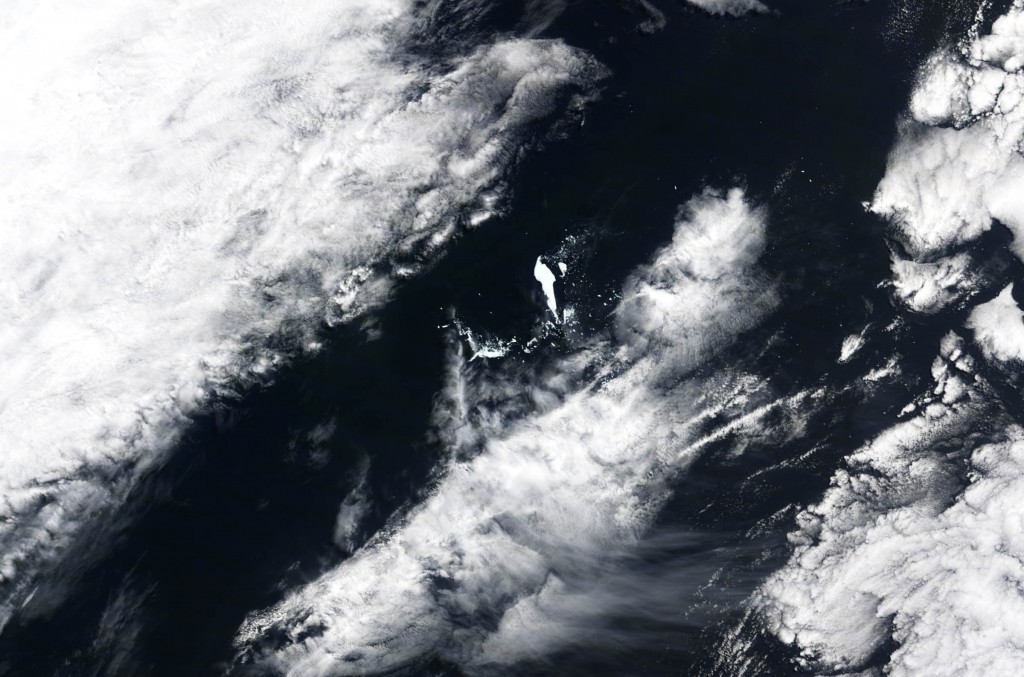
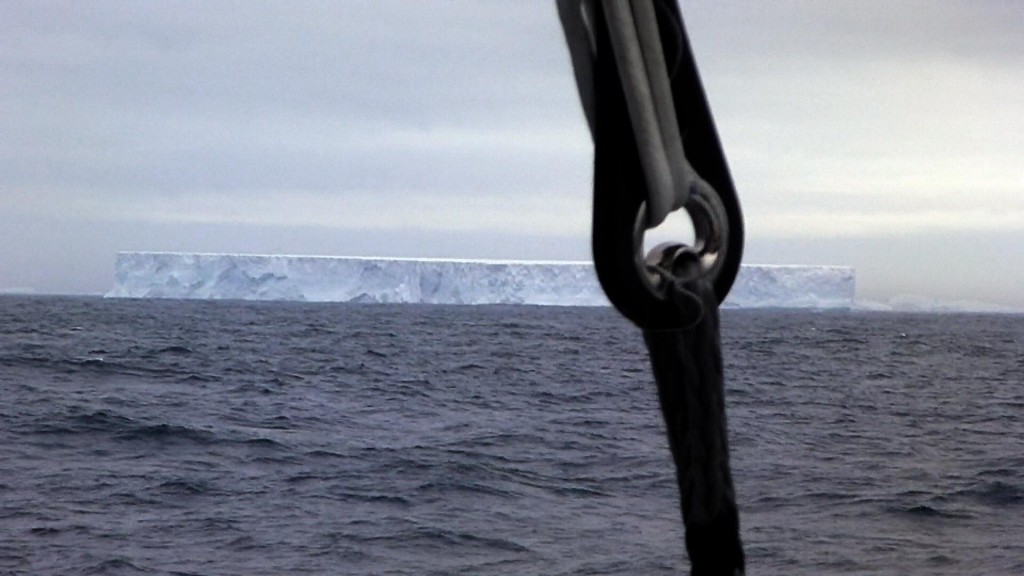 Satellite view of the B15J iceberg. The same iceberg, pictured from Banque Populaire V, on the 16th of December 2011. © BFBP
Satellite view of the B15J iceberg. The same iceberg, pictured from Banque Populaire V, on the 16th of December 2011. © BFBP
Stuck in the anticyclone awaiting it, BPV would take another six days to exit the Pacific. On 21 December, the mythical cape was finally in the bow’s reach. “I’ve got a little dilemma at the moment because going right near Horn, at the request of half of the crew that’s never seen it, would fulfill the greatest wishes of some, but on the other hand, we risk getting into 35-40 knots (74 km/h) of wind and I’m not that keen on this,” warned Loïck Peyron. With a little more than 600 miles (965 km) ahead of the Groupama time, compared with its 2000-mile (3218 km) lead a few days earlier, the skipper didn’t hesitate for long.
On 23 December, the Banque Populaire V trimaran went over the longitude of the southern tip of America, after 30 days, 22 hours, 18 minutes and 48 seconds of sailing. In other words, they were over a day under Franck Cammas’ time in 2010(8)(8)The skipper made no improvement on the WSSRC record for crossing the Pacific Ocean, from the southern tip of Tasmania to Cape Horn – the title was kept by his brother Bruno Peyron who followed this course in 8 days, 18 hours and 8 minutes. A record set on the catamaran Orange II in 2005.. But the sailors wouldn’t get to see the Horn up close.
“Bonjour, Northern Hemisphere!”
At the entrance of the Atlantic, a little effort was made to go eastwards in order to latch onto a flow generated by a depression centered on the Falklands towards the east, before heading north, homebound! The beneficial effects of the depression dissipated around Uruguay but gaining a 900-mile (1448 km), then 1000-mile (1609 km) lead on the reference time allowed the crew to envisage climbing up serenely at 15 knots… Upwind.
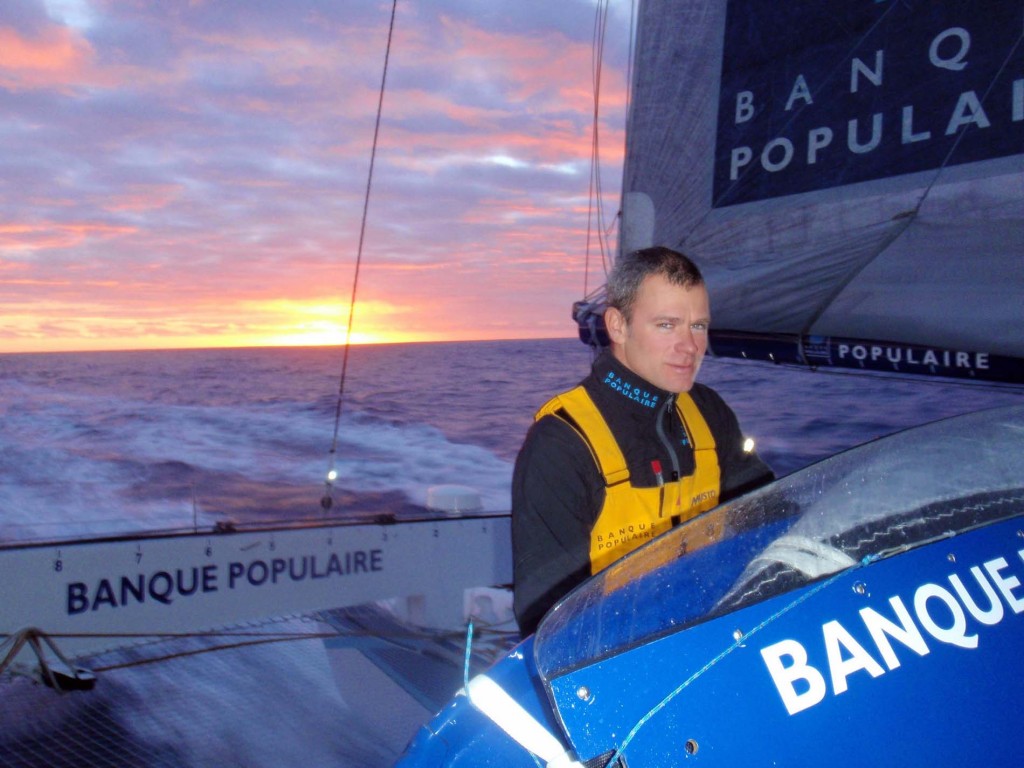 Thierry Chabagny. Photo du bord / © BFBP
Thierry Chabagny. Photo du bord / © BFBP
The northeasterly wind around the Brazilian coast left the BPV crew no choice except a tame pace that countered high performance. But this was nothing out of the ordinary in these latitudes, and the blue trimaran still managed to get to the northern hemisphere with an advance of 3 days, 18 hours and 24 minutes on Groupama 3’s time from two years earlier(9)(9)The Banque Populaire Team covered the Ushant-Equateur (return) leg in 38 days, 2 hours, 45 minutes and 48 seconds, compared with the 41 days, 21 hours and 9 minutes recorded by Franck Cammas and his crew.. “We went over the equator at high speed. We’re doing 35 knots on a practically flat sea. Pure joy,” rejoiced the BPV skipper on 30 December. “The boat’s not suffering, the guys even less. Everyone’s delighted, especially the first time Cape Horners. Bonjour, Northern Hemisphere!”
Final detour
It seems that on this tour, every happy episode had its flipside. As soon as the 0° latitude was passed, BPV’s 14 crewmembers were shaken up by 34 knots (62 km/h) of wind and a choppy sea all night long.
As 2012 dawned, BPV sailed in optimal conditions along the latitude of the Antilles. But further north, the Azores High set up base across the Atlantic, blocking the whole of the direct path to Brittany. For a moment, Peyron envisaged cutting through the ridge despite the boat-breaking sea, but prudence won out once again. More than ever, it was necessary to look after the equipment. What’s more, the skipper knew that the record was his and that gaining more time would be pure greed. “Fast but not furious”: this was the motto on board.
It was thus after a large detour to the west that the 14 crewmembers finally entered the Channel via the Irish Sea. The blue rocket swallowed up the last miles separating it from victory, at an average of 35 knots. The arrival line was crossed on 6 January, at 22 hours (GMT), the obscurity broken by flashes from Europe’s most powerful light, streaming from the lighthouse at Ushant, the Créac’h.
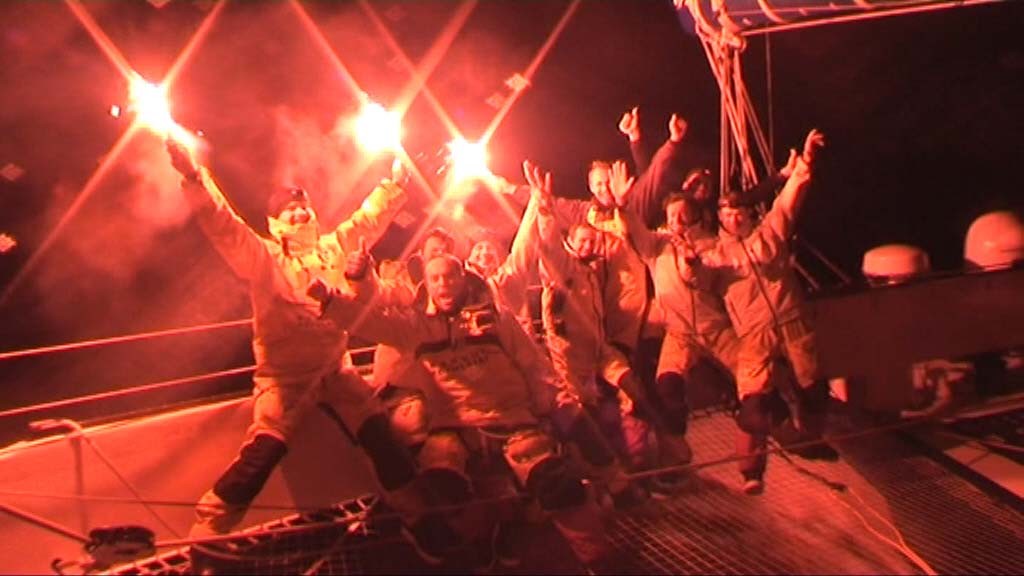 Photo du bord / © BFBP
Photo du bord / © BFBP
Banque Populaire V’s fourteen crewmembers had just covered 29,002 miles (46674 km) at an average speed of 26.51 knots, in 45 days, 13 hours, 42 minutes and 53 seconds. They had smashed the existing circumnavigation speed record. They were the new holders of the Jules Verne Trophy.
A few days earlier, during a radio session, Loïck Peyron had paid discreet but deeply felt homage to the collective work leading to the record: “We can feel that lots of work was done on the boat in the last three years, not just in the design but also in navigation. All this certainly didn’t start when I arrived.” And he added, even before going over the finish line: “Technically, everything’s going to improve, and it’s obvious that this record will probably be broken in a few years’ time…”(10)(10)Radio session, January the 4th , with Loïck Peyron.
The skipper didn’t yet know that his next challengers would be borrowing the same vessel three years later: a legendary maxi trimaran, now dressed in black and gold, rebaptized Spindrift 2…
13h | 42min | 53s
2012
2016-11-24
20H45
27°08 N
20°48 W
23
LOADING...
2012-12-02
20H45
44°31 S
07°26 W
33
LOADING...
2012-12-10
20H45
42°59 S
122°25 E
27
LOADING...
2012-12-25
21H00
37°16 S
34°24 W
26
LOADING...
2012-01-02
21H00
27°55 N
52°42 W
21
LOADING...
2012-01-05
21H00
51°59 N
25°05 W
66
29
LOADING...

